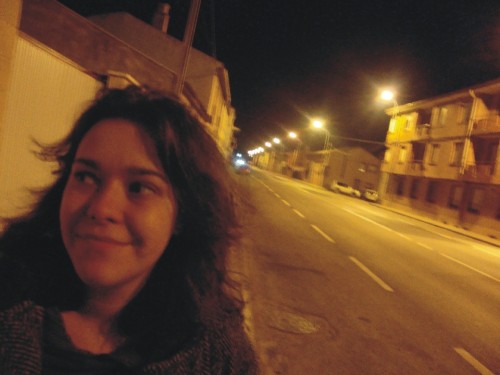Ana Gorría (Barcelona, 1979) has published Clepsidra (Clepsydra) in 2004; Araña (Spider) in 2005 in collaboration with painter Pepa Cobo and composer Juan Gómez Espinosa; the booklet De lo real y su contrario (From the Real and its opposite) in 2007; and Latidos (Heartbeats), illustrated by painter Pepa Cobo. Her work has been translated into English, French, Italian and German, and included in several anthologies in Spain, Chile and Perú. In collaboration with poet James Womack, she has translated into Spanish a selection of the work of British poet John Ash under the title Travesía escéptica (Sceptic crossing), and has made versions of Galician poet Chus Pato.
How would you define yourself?
As a poet, that is, as someone who wants and expects to find in the poetic language the keys for opening, perhaps even understanding, that cannot be found in the rest of instances of everyday’s life. The dissatisfaction that we experiment in everyday’s language drags the poem like a mirror where we can all look at ourselves, learn and, perhaps, not only organize ourselves, but also carry out some of the organization of the representation which our lives unfold. That’s what I wanted to do in my previous books and what I keep trying to do at present.
What can the audience expect from your collaboration with Spain NOW!?
I always thought that the term audience or spectator is excessive for a poem, given the exceptionality of the communication proposed: that of radical intimacy. However, the collaboration brought to Spain NOW! is a collaboration with screens: the fabulous illustrations by Sonia Pulido that interact with the images and play amongst them. Words and illustrations, dancing as in a waltz. I hope the viewer and the judge of this game can make their own conclusions and participate in the creative joy that we have been working on. We both wanted to open doors. We expect the visitor to decide to pass through them and find the small worlds that have spread across the page. For me the word that can best define the experience would be “dwellers”.
What do you think your collaboration with Spain NOW! will bring for you?
First, it allowed me to meet some authors of my country who are doing a work to which I can feel related and did not know. Second, working hand-in-hand with Sonia Pulido has been warm and beautiful. I have learned a lot and I am very happy with the result. Had it been a different kind of event, I would never have done what I did to the text presented. The creative process has been delicious and fun and has also given me the opportunity to meet one of the best illustrators in Spain.
Describe or give us some insights about your creative process.
In the same way as in my previous texts, the creative process itself is the poem.There are no a priori assumption formulas; the process of searching against the language is what makes the poem occur as the sediment of this process. In the case of the poem for Spain NOW! Sonia and I have worked in the same direction, emphasizing the playful component. We strarted with a vignette from her “flyers”, I proceeded to send a text that was spreading across the page. Doing this work has been like playing scrabble between letters and pictures, developing links, filling and emptying the space of the page.
Where have you shown internationally before? And in Spain?
Poetry is not usually shown “this way”. The poet is dragged to poetry and poetry urges him to say (as illustrated by Sonia with the girl with the megaphone), or, when the poems are translated, the poet says its words in another language. In that sense, I have been urged to say or have been published in Peru, Chile, Portugal, Slovakia, the UK, the US or the Dominican Republic, amogst other places.
What can you say about the current state of Spanish culture within your field?
All those who write poetry and, above all, read it, know that it is a complicated art. This is an old art, that could be traced back to the Rome of Catullus, and yet despite that the institution is an institution somehow reactionary (but not poetry or poets). I think we should greet with joy the many people who are producing poetry, opening roads and spaces through new platforms and publishers with minimal presence to help shape today’s quite extensive Spanish poetic tissue.
What other emergent Spanish artists can you recommend for those who enjoy your work?
There are many names of poets I appreciate, like Julia Piera, Marcos Canteli, Olga Novo, Estíbaliz Espinosa, Carlos Fernández López, Sandra Santana, José Luis Gómez Toré, Eva Chinchilla, Esther Ramon, Unai Velasco, María Salgado, Cristian Law Palacín, Miriam Reyes, Chus Arellano, Julieta Valero, Ignacio Miranda, Juan Soros, Manel Forcano, Branca Novoneyra, Joan de la Vega, Ruth Miguel Franco, Pablo López Carballo, Sara R. Gallardo, Javier Vicedo Alos or Luna Miguel. These are only a few names of poets in which I value the aesthetic independence and the originality of their proposals. I also have in mind the “teatremas” made by Patricia Esteban.
Do you have affinities or share interests with any artists working in the UK?
I translated the work of John Ash, a great English poet, in collaboration with an English poet living in Spain, James Womack. I’ve also done versions of authors such as Annie Katchinska, Adam O’Riordam or James himself for variousmagazines. I also know the work of Jeff Hilton. I think in England poets of all ages are doing a great job and I particularly enjoy working with them.

